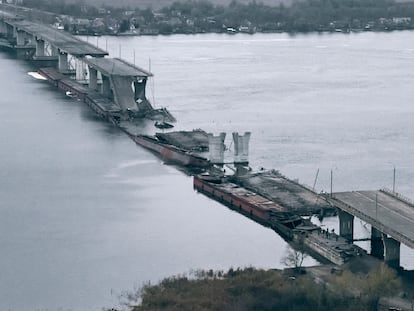Ukraine’s frontier of hunger: 40% of those who live near the front lines do not have enough food
Over two million people need humanitarian aid in a country where poverty has skyrocketed and staple items are 35% more expensive than a year ago

His name was Oleksandr. He came from a neighboring town and became the transmission belt with the Russian occupiers in the village of Hnilitsia, in the Kharkiv region. This collaborator was trying to cajole local Ukrainian authorities into working with the invaders. The authorities of the village, half of whose population of around 1,000 has already fled, refused. Despite everything, there were no reprisals, as local officials themselves acknowledge.
The Kremlin’s troops met with more resistance in the surrounding towns, where they set up camp at the very beginning of the invasion, on February 24. The Russian soldiers fled on September 11 in the middle of the local army’s counteroffensive. Oleksandr, the liaison man, also vanished. The locals think he crossed the Russian border, some 18 miles away. Unlike other nearby villages, which sustained serious damage from the fighting, the houses in Hnilitsia are still standing. But the population now depends on humanitarian aid to survive.
As a result of the armed conflict, one in three Ukrainians suffers from food insecurity and up to 40% of people in war-affected regions in the east are not getting sufficient amounts of food, according to the World Food Programme (WFP). In the last year, the price of the average shopping basket has risen 35%, notes the director of that United Nations agency in Ukraine, Matthew Hollingworth, during an interview with EL PAÍS in Kyiv. In addition, the Russian invasion has pushed up the poverty rate from 2% to 25%, according to World Bank estimates. That figure could reach 55% by the end of next year, said Arup Banerji, the World Bank’s director for Eastern Europe, in an interview with Reuters in mid-October.
Two vans drive out of a huge warehouse in the city of Kharkiv, loaded with food. They are going to Hnilitsia, about three hours away by road. Loaded in the back of the vans are 300 individual rations. Each box weighs over 27 pounds and contains wheat flour, oil, salt, sugar and cans of meat and beans. These care packages are prepared by the UN World Food Programme (WFP) and distributed by the local humanitarian organization ADRA. Next to the bus stop, where one of the two delivery points are located, there is a grocery store and a few customers can be seen going in and out. But most people here are simply lining up to collect food from the NGO. That 35% increase in food prices “is a very large increase and a direct consequence of the war,” explains Hollingworth, adding that in many places there is not even a store to shop in anymore.
In eastern and southern Ukraine, there are about 2.5 million people living near combat zones. Many are Ukrainians who have not been able to escape to safer areas due to economic problems or lack of family ties, Hollingworth explains. “Most of those who stayed behind had no choice, and there are many older people who are alone or disabled.” Moscow has so far ignored all WFP requests and is not allowing humanitarian assistance in the parts of Ukraine occupied by its troops. Although they cannot reach those territories, the agency is helping 2.8 million people a month elsewhere in the country with basic food items or with vouchers redeemable in stores.
Covered in a green headscarf, Maria Fediuk, 79, can barely manage her box of groceries, which she just picked her up on the road leading to Hnilitsia. A widow for six years now, she has spent the occupation alone, without family, without any garden vegetables or animals to provide nourishment. She says that the few savings she has are used for medicine. As a young woman, she used to work in a day care center, then later turned to agriculture. She tended cows and milked them, but that was until the farm closed. Asked if she misses the country’s Soviet past, the woman purses her lips and shakes her head without opening her mouth.
“They don’t want us to be better off than they are. That’s why [Vladimir] Putin wants to take our land, which is very productive. All Russians are jealous of Ukraine,” says Oleksandr Zelenskiy, 69, who bursts out laughing when he notes that his last name is the same as the Ukrainian president’s. In any case, he clarifies that the Russians “did not do horrible things here.” “They took the car of one of the neighbors, but they didn’t kill anyone,” he explains. Zelenskiy waits with several dozen people for his food box. For this man, who came to Hnilitsia in 1977 as a teacher, the main problem now is not so much food as the lack of cellphone reception and internet connection. “We have to go up there to connect,” he adds, pointing to a nearby hill. Next to him, Gregori Babak, 63, one of the local leaders, says that the top requirement for residents of the area “is peace.”
A dark forecast until spring
The director of the WFP paints a dark picture of what to expect between now and the spring. In addition to the lack of resources for the population living near the front lines, there are now millions of victims of the systematic attacks on energy infrastructure carried out by the Russians in recent weeks. The last one – and the most compelling, according to the authorities – took place on Tuesday of last week. This has made the geographical scope of vulnerability much broader, Hollingworth notes. Another problem is the area under Russian occupation, to which they have not been able to gain access. “We know that there are people in need there,” he says, based on his experience in other areas recently recaptured by the Ukrainians. But they do not have a permit allowing them to go in. The head of the WFP in Ukraine says they will not stop knocking on the door, but, so far, Moscow has not opened it.
The seniority of Nikola Vitsota, 52, has elevated him to the leadership of one of the two areas into which the village is divided. He was the one who refused to collaborate with the Russians. He was also in charge of putting away all documentation that could be compromising or of some value to the occupants. He is grateful that the destruction has not been similar to what happened in towns like Izium, in this same region. There are also no deaths to report: the Russians, who entered Hnilitsia on February 24 due to its proximity to the border, took away a former soldier for a three-day interrogation, but that was all, says Vitsota, proudly showing a video on his cellphone that captures the moment when he had the honor of raising the blue and yellow flag of Ukraine again when the military entered to liberate the town.
In Hnilitsia there are hardly any young people left. There were about 30 children before the war, but only about 10 remain, Vitsota estimates. A 21-year-old woman named Valeria shows up for her care package, looking oddly young among the others. She has two children, the eldest of whom is three. The little one was born just a week before the invasion. Standing near her is Maria Fediuk, the old woman who lives alone. Her box of food sits on the bench at the bus stop. It is too heavy for her, and she has no ride home. Some neighbors are carrying their own boxes as best they can, teetering on bicycles or on wheelbarrows. “I don’t know how I’m going to get back. I haven’t thought about it yet,” laments Fediuk.
She is not the only villager who has this problem. But war not only brings out the worst in human beings, it also brings out the best. Soon, neighbors with cars show up to help the others. It is the law of solidarity on the frontiers of hunger. Going forward, the biggest challenge will be for the population to become self-sufficient once again, notes the WFP director, because emergency aid cannot last forever.
Sign up for our weekly newsletter to get more English-language news coverage from EL PAÍS USA Edition
Tu suscripción se está usando en otro dispositivo
¿Quieres añadir otro usuario a tu suscripción?
Si continúas leyendo en este dispositivo, no se podrá leer en el otro.
FlechaTu suscripción se está usando en otro dispositivo y solo puedes acceder a EL PAÍS desde un dispositivo a la vez.
Si quieres compartir tu cuenta, cambia tu suscripción a la modalidad Premium, así podrás añadir otro usuario. Cada uno accederá con su propia cuenta de email, lo que os permitirá personalizar vuestra experiencia en EL PAÍS.
¿Tienes una suscripción de empresa? Accede aquí para contratar más cuentas.
En el caso de no saber quién está usando tu cuenta, te recomendamos cambiar tu contraseña aquí.
Si decides continuar compartiendo tu cuenta, este mensaje se mostrará en tu dispositivo y en el de la otra persona que está usando tu cuenta de forma indefinida, afectando a tu experiencia de lectura. Puedes consultar aquí los términos y condiciones de la suscripción digital.
More information
Archived In
Últimas noticias
The impact of Ecuador’s mega-prison: A polluted river, cleared forests and military checkpoints
Corinne Low: ‘I’m more concerned about the female happiness gap than the gender wage gap’
Trump traveled on Epstein’s plane ‘many more times’ than previously thought, according to new documents
Venezuelan exiles in Madrid scramble to salvage Christmas plans after flight cancellations
Most viewed
- The low-cost creative revolution: How technology is making art accessible to everyone
- Christian Louboutin: ‘Young people don’t want to be like their parents. And if their parents wear sneakers, they’re going to look for something else’
- All the effects of gentrification in one corner of Mexico’s Colonia Roma
- Liset Menéndez de la Prida, neuroscientist: ‘It’s not normal to constantly seek pleasure; it’s important to be bored, to be calm’
- Christmas loses its festive spirit: ICE fears cast shadow over religious celebrations










































